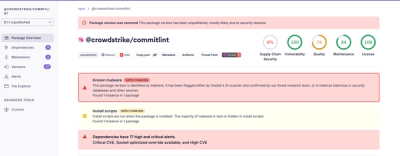
Research
Malicious fezbox npm Package Steals Browser Passwords from Cookies via Innovative QR Code Steganographic Technique
A malicious package uses a QR code as steganography in an innovative technique.
postcss-gap
Advanced tools
PostCSS plugin to create fallbacks for the css properties row-gap, column-gap and gap.
PostCSS plugin to create fallbacks for the css properties row-gap, column-gap and gap..
See the current css spec for further details.
.foo {
gap: 3vmin 2vmax;
row-gap: 1em;
}
[column-gap] {
column-gap: initial;
}
.foo {
grid-gap: 3vmin 2vmax;
grid-row-gap: 1em;
}
[column-gap] {
grid-column-gap: initial;
}
/* default usage, with no options (method = replace) */
postcss([ require('postcss-gap') ])
/* add the fallbacks right before, but keep the original css props (row-gap, column-gap and gap)*/
postcss([ require('postcss-gap') ])({ method: 'duplicate' })
See PostCSS docs for examples for your environment.
FAQs
PostCSS plugin to create fallbacks for the css properties row-gap, column-gap and gap.
The npm package postcss-gap receives a total of 390 weekly downloads. As such, postcss-gap popularity was classified as not popular.
We found that postcss-gap demonstrated a not healthy version release cadence and project activity because the last version was released a year ago. It has 1 open source maintainer collaborating on the project.
Did you know?

Socket for GitHub automatically highlights issues in each pull request and monitors the health of all your open source dependencies. Discover the contents of your packages and block harmful activity before you install or update your dependencies.

Research
A malicious package uses a QR code as steganography in an innovative technique.

Research
/Security News
Socket identified 80 fake candidates targeting engineering roles, including suspected North Korean operators, exposing the new reality of hiring as a security function.

Application Security
/Research
/Security News
Socket detected multiple compromised CrowdStrike npm packages, continuing the "Shai-Hulud" supply chain attack that has now impacted nearly 500 packages.